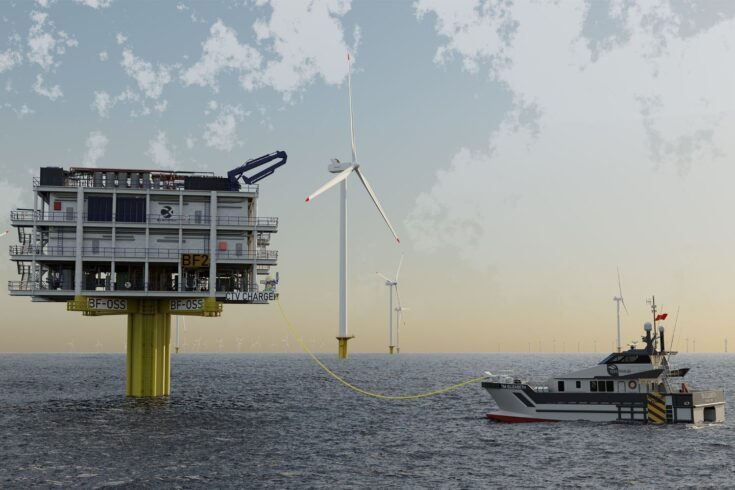Tidal Transit, the purpose-design crew vessel experts, has created a novel project alongside industry experts to showcase an all-electric crew boat for the offshore wind industry.
Fuel usage among crew transfer vessels (CTVs) is substantial. With around 300 CTVs working in the European offshore wind industry, an estimated 164 million litres of diesel fuel is used each year. Creating over 400 million tons of carbon dioxide emissions. As a result, this operation is a key target for net zero innovation in the maritime sector.
While new-build vessels that are powered by novel fuels can help make a difference, the emissions involved in manufacture mean that retrofit presents a more viable solution.
Retrofit 20m Mercurio CTV: 100% electric
The Retrofit 20m Mercurio CTV project partners bring a wealth of experience in vessel operation, building and repair, as well as in both electrical systems and vessel charging solutions.
They will focus on the concept of retrofit benefits. Beginning with an overhaul of one CTV’s power system to showcase the operational capabilities of electric power for the transport of crew to offshore wind power facilities.
This project builds upon previous successes in charging infrastructure development, introducing greener on-shore and off-shore points to support the operations of the vessel at different stages of the journey.
The project scope
Tidal Transit is working in partnership with Goodchild Marine Services, alongside charging infrastructure specialists Artemis Technologies and MJR Power & Automation and a range of expert equipment suppliers.
The project will see the full retrofit of an existing Mercurio vessel. This work will involve the removal of all internal fixtures and fittings within the vessel hull, including the current engines and propulsion systems, fuel tanks and ensuite accommodation. In place of this, the vessel will be retrofitted with a system comprising of three megawatts of batteries, electric motors, and propulsion pods.
The retrofit vessel will be able to charge from existing infrastructure, while the project is also increasing availability with the installation of a battery-backed onshore charging solution in the port. The CTV in use will also benefit from the inclusion of an offshore wind turbine-based charger to extract the lowest cost electricity directly from source.
Ahead of a three-year demonstration, the project is looking to gather data on the performance and effectiveness of the vessel. Capturing any wider environmental, economic, and social benefits, and further opportunity to extend its use elsewhere.
Aims and ambitions
The £20 million Mercurio project aims to complete a successful and fully tested retrofit reconstruction of the vessel hull and power system in 2024. Then allowing it to replace an existing vessel currently in operation to provide comparative data and efficiency analysis.
Further compelling energy performance and efficiency data will also be gathered from the new supporting charging points. The project is aiming to demonstrate the ease of installation and the benefits to the sector in terms of upskilling a workforce and developing a knowledge of novel energy use. These are essential in building on ongoing relationship with regulation and demonstrating both compliance and opportunity in this space.
Beyond the emissions benefits, the project is looking to identify the impact of wider benefits such as reduced noise pollution for port operators and the onboard crew. Increased maneuverability will also be demonstrated, showcasing the advantage these vessels can have in maintaining stationary positions on the water.
These broader benefits form part of another objective to increase engagement and uptake among the industry, potential customers and other sectors with similar ambitions. Tackling reticence that still exists around electric power and the cost of conversion is important for the project. Along with proving the possibility of achieving net zero aims through repurposing rather than new building is key to this story.
Looking at the opportunity for the offshore wind sector, Leo Hambro, Director at Tidal Transit, said:
All utilities are under pressure to decarbonise away from fossil fuels, and we’re reaching a point now where everything that can be electric should be electric in the sector. The offshore wind industry needs to be greener, as using diesel fuel to facilitate the generation of electric wind power is a limitation that we want to be at the forefront of overcoming. Through this project and our future plans, we aim to be able to showcase how the electric power concept can be replicated and expanded across the UK maritime sector.
About the funding
This project is part of the Zero Emission Vessels and Infrastructure (ZEVI) scheme, funded by UK government.
As part of ZEVI, the UK Department for Transport has allocated £80.4 million funding to 10 projects. The funding is to build clean maritime vessel and infrastructure solutions by March 2025 and operate them until March 2028. The projects are supported by 52 organisations across the UK and will leverage over £40 million private investment.
The ZEVI scheme is part of the department’s UK Shipping Office for Reducing Emissions programme. A £206 million initiative focused on developing the technology necessary to decarbonise the UK domestic maritime sector. The ZEVI scheme is delivered by Innovate UK.
Top image: Mercurio vessel charging offshore. Credit: Tidal Transit

